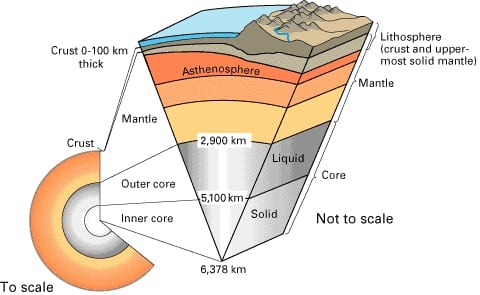Geothermal energy may be defined as heat energy from beneath the surface of the earth. It is radiated from the mantle, and into the crust. Therefore, the deeper one drills, the hotter it becomes, as you approach the heat source. There is an upper mantle, and a lower mantle. Intuition has probably told you by now that the upper mantle is above the lower mantle, and is under the crust.

The lower mantle is a partially molten layer of rock underneath the upper mantle. The upper mantle is a dense and extremely hot layer of rock under the crust of the earth. The upper mantle radiates heat up into the crust, where it can be used for heating and electricity generation. The mantle is approximately 2,900 kilometers (1,740 miles) thick, and is above the outer core, which is above the inner core.
Geothermal Space and Water Heating/Cooling
Geothermal Heat Pumps
Heat from within the earth is sometimes used by homeowners to heat some of the rooms in their homes or to heat water. Throughout the year, a few feet below the surface of the earth, the temperature is stable and is usually between 45-58° F.
Heating
A fluid is pumped through a coil of tubing that is buried underground where it is 45-58° F. The fluid absorbs heat from the soil underground and is pumped up through radiators inside the building which radiate that same heat in the fluid into the room. The fluid eventually cools off as its heat is radiated into the building, and it is then pumped back down underground to be heated using the same process I mentioned again.
Cooling
This is mechanically the same process as mentioned in the heating section, but this involves transferring heat from the air in the room to the geothermal tubes underground which radiate it into the soil. This works because the soil is cooler than the air is during warm weather periods such as summer.
The difference between geothermal heating and cooling is that because the temperature underground is 45-58 °F, during the summer (or any other warm time of year), heat flows in the opposite direction.
This means that because the air temperature inside the building is higher than the temperature underground (over 80 °F vs 45-58 °F), the fluid is heated to a warm temperature that is above 70 °F by the hot summer air and the 45-58° F soil underground absorbs the heat from that fluid until it becomes cool. This is due to the fact that heat travels to cooler places automatically. The cool fluid is then pumped up to the same radiators I mentioned in the heating section above, but the cooled fluid makes them cool, and they in turn cool the air with the assistance of fans.
A More In-Depth Explanation of Both
Pipes are buried underground and a fluid is circulated through them, and since heat moves to cooler places, during the winter, the heat is transferred to fluid from and it then heats radiators inside the house, and during the summer, the warm fluid from above the surface which was circulated through the same radiators is cooled by the 45-58 °F temperature earth and that cool fluid is circulated through the radiators again, cooling them, and then heat is transferred from the air to them, and then to the liquid which has to be cooled via the geothermal process again.
The radiators that I am referring to are heat exchangers which resemble car radiators because they are metal (aluminium or copper) coils with aluminium fins attached to them.
They make it possible to efficiently transfer heat between the air and liquids. They are called liquid to air heat exchangers and fans are used to pass air between their fins. Geothermal heat pumps can be used to preheat water to reduce the duration of time that your electric or gas water heater operates, saving electricity.
Advantages:
- Low power consumption: Only a fan and pump are required.
- No open flame nor gas to cause fires or explosions.
- They do not pollute the air, apart from the minimal emissions resulting from the power consumption of the fans and pump.
Disadvantages:
- The capital cost is high.
Geo-exchange Heat Pumps
Geo-exchange heat pumps use heat pumps such as reverse cycle air conditioners to literally draw heat from the earth and transfer it to the radiators inside your building.
In order to understand this process, you need to read: How Air Conditioners Work.
Geothermal Power Plant
Geothermal power plants generate electricity by circulating extremely hot water from underground through a steam generator to generate heat. The water can be used directly to heat a boiler, and steam from underground can also be used to turn steam turbines. After the boiler is heated using geothermal water, it generates steam which is used to turn steam turbines which generate electricity.




